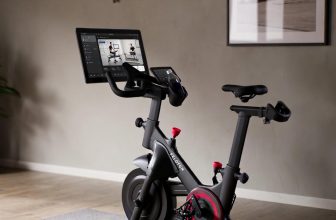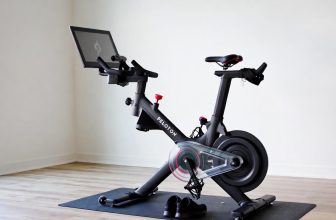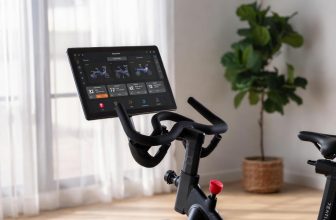Table of Contents
- Which Exercise Bike is Best After Knee Replacement?
- Why Exercise Bikes Are Ideal for Knee Replacement Recovery
- Benefits of Cycling Post-Surgery
- Types of Exercise Bikes for Knee Replacement Recovery
- Recumbent Bikes: Top Choice for Comfort
- Upright Bikes: For Advanced Recovery
- Specialty Bikes: ROMtech Portable Connect
- Key Features to Look for in an Exercise Bike
- How to Use an Exercise Bike Safely Post-TKR
- Setup and Technique
- Recommended Routine
- Safety Tips
- FAQs About Exercise Bikes After Knee Replacement
- Final Thoughts
- About Author
- Mariar Fernandez
As an Amazon Associate, I earn from qualifying purchases.
Which Exercise Bike is Best After Knee Replacement?
Which Exercise Bike is Best After Knee Replacement? Recumbent bikes, like the NordicTrack Commercial R35 or Schwinn 270, are often the best choice after knee replacement due to their low-impact design, adjustable seating, and back support, promoting safe recovery.
Why Exercise Bikes Are Ideal for Knee Replacement Recovery
Exercise bikes are a cornerstone of post-knee replacement rehabilitation, offering low-impact exercise that minimizes joint stress while promoting mobility. According to a 2021 study in BMC Musculoskeletal Disorders, cycling improves knee flexion by 10-15 degrees after 8 weeks of use in total knee replacement (TKR) patients. Recumbent bikes, in particular, are recommended for their ergonomic design, which supports the back and reduces strain on the new joint.
Benefits of Cycling Post-Surgery
- Low-Impact Movement: Reduces stress on the knee compared to walking or running, with a Journal of Physiologia study noting a 20% lower joint load than treadmills.
- Enhanced Range of Motion: Encourages synovial fluid production, lubricating the joint, per the American Academy of Orthopaedic Surgeons.
- Muscle Strengthening: Targets quadriceps and hamstrings, with a 2015 Acta Physiologica Hungarica study showing 15% strength gains after 12 weeks.
- Cardiovascular Health: Burns 150-300 calories per 30 minutes, aiding weight management, which reduces knee stress by 4 pounds per pound lost (Osteoarthritis and Cartilage).
For more on post-TKR exercises, see the American Academy of Orthopaedic Surgeons’ TKR Exercise Guide.
Types of Exercise Bikes for Knee Replacement Recovery
Recumbent Bikes: Top Choice for Comfort
Recumbent bikes are favored for their reclined seating and backrest, reducing strain on the knees and back. A 2025 Vanswe Fitness article highlights their adjustable seat positioning and pedal distance, ideal for TKR patients. Key features include:
- Adjustable Seats: Allow proper knee alignment, critical for safe pedaling.
- Back Support: Minimizes lower back strain, per Physical Therapy Journal.
- Ease of Use: Easier to mount/dismount, vital for early recovery.
Top Picks:
- NordicTrack Commercial R35: Features a 14-inch HD touchscreen with iFit integration for guided workouts, 26 resistance levels, and a cushioned seat. Priced around $1,299, it’s ideal for tech-savvy users but requires an iFit subscription ($39/month) for full features.
- Schwinn 270 Recumbent Bike: Offers 25 resistance levels, Bluetooth connectivity, and a padded seat for $599-$799. Rated 4.5/5 stars on Amazon for comfort.
Upright Bikes: For Advanced Recovery
Upright bikes mimic traditional cycling, requiring at least 100 degrees of knee flexion, per PT Progress. They engage core muscles but demand more strength, making them suitable 4-6 weeks post-surgery.
Top Pick:
- Exerpeutic Stationary Bike: Foldable, with an 8-level tension system and heart rate monitor, priced at $150-$200. Ideal for small spaces and budget-conscious buyers.
Specialty Bikes: ROMtech Portable Connect
The ROMtech Portable Connect Bike, used in clinical settings, offers telehealth monitoring for personalized rehab. A 2020 OSC Ortho study noted faster recovery with its use, though it’s less accessible for home use due to cost and availability.
For bike comparisons, visit Everyday Health’s guide to exercise bikes for knee rehab.
Key Features to Look for in an Exercise Bike
When selecting a bike, prioritize features that ensure safety and effectiveness:
- Adjustable Seat and Pedals: Ensure slight knee bend at the pedal’s lowest point to avoid strain (Physiologia, 2024).
- Low Resistance Options: Start with minimal resistance to protect the joint, per Wright Physical Therapy.
- Comfort Features: Look for padded seats, backrests, and easy-to-read consoles, as noted in Torokhtiy’s 2025 review.
- Smart Features: Touchscreens or app integration (e.g., iFit) enhance engagement but may increase costs.
| Bike Type | Price Range | Knee Flexion Needed | Best For | Comfort Level |
|---|---|---|---|---|
| Recumbent | $150-$1,500 | 90-100° | Early Recovery | High |
| Upright | $100-$500 | 100-110° | Advanced Recovery | Moderate |
| ROMtech | Custom | 90-100° | Clinical Rehab | High |
How to Use an Exercise Bike Safely Post-TKR
Setup and Technique
Proper setup is critical to avoid injury:
- Seat Height: Adjust so the knee is slightly bent at the pedal’s lowest point (Vanswe Fitness).
- Start with Reverse Pedaling: Easier for limited range of motion, per Verywell Health.
- Low Resistance: Begin with 5-10 minute sessions, increasing gradually, as advised by Wright Physical Therapy.
Recommended Routine
- Timeline: Start 2-4 weeks post-surgery, with doctor approval (Practice Plus Group).
- Frequency: 3-5 sessions weekly, 10-20 minutes each.
- Progression: Increase duration and resistance after 4-6 weeks, per Medical News Today.
Safety Tips
- Monitor Pain: Stop if discomfort arises and consult a doctor (Total Therapy Solutions).
- Pre-Hab: Use the bike before surgery to build strength, reducing recovery time by 20%, per X10 Therapy.
- Physical Therapy Guidance: Work with a therapist to tailor routines.
Learn more about safe cycling techniques at Mayo Clinic’s knee rehab guide.
FAQs About Exercise Bikes After Knee Replacement
Which is better: recumbent or upright bike post-TKR?
Recumbent bikes are better for early recovery due to lower knee flexion needs and back support. Upright bikes suit advanced stages, per PT Progress.
How soon can I start cycling after TKR?
Most patients begin stationary cycling 2-4 weeks post-surgery, with outdoor cycling possible at 8-12 weeks, per Practice Plus Group.
Can cycling wear out my knee replacement?
Low-impact cycling is unlikely to damage prosthetics if done correctly, but overuse should be avoided, per Joint Replacement Center of Scottsdale.
Are budget bikes effective for rehab?
Yes, affordable options like the Exerpeutic Stationary Bike provide sufficient features for recovery, per Torokhtiy.
Final Thoughts
Selecting the right exercise bike after knee replacement is crucial for a safe and effective recovery. Recumbent bikes, like the NordicTrack R35 or Schwinn 270, excel for their comfort and low-impact design, while upright bikes suit later stages. Prioritize adjustable, user-friendly features and consult your doctor or physical therapist to ensure safe use. With consistent, guided cycling, you can regain mobility, strengthen muscles, and return to an active lifestyle.







